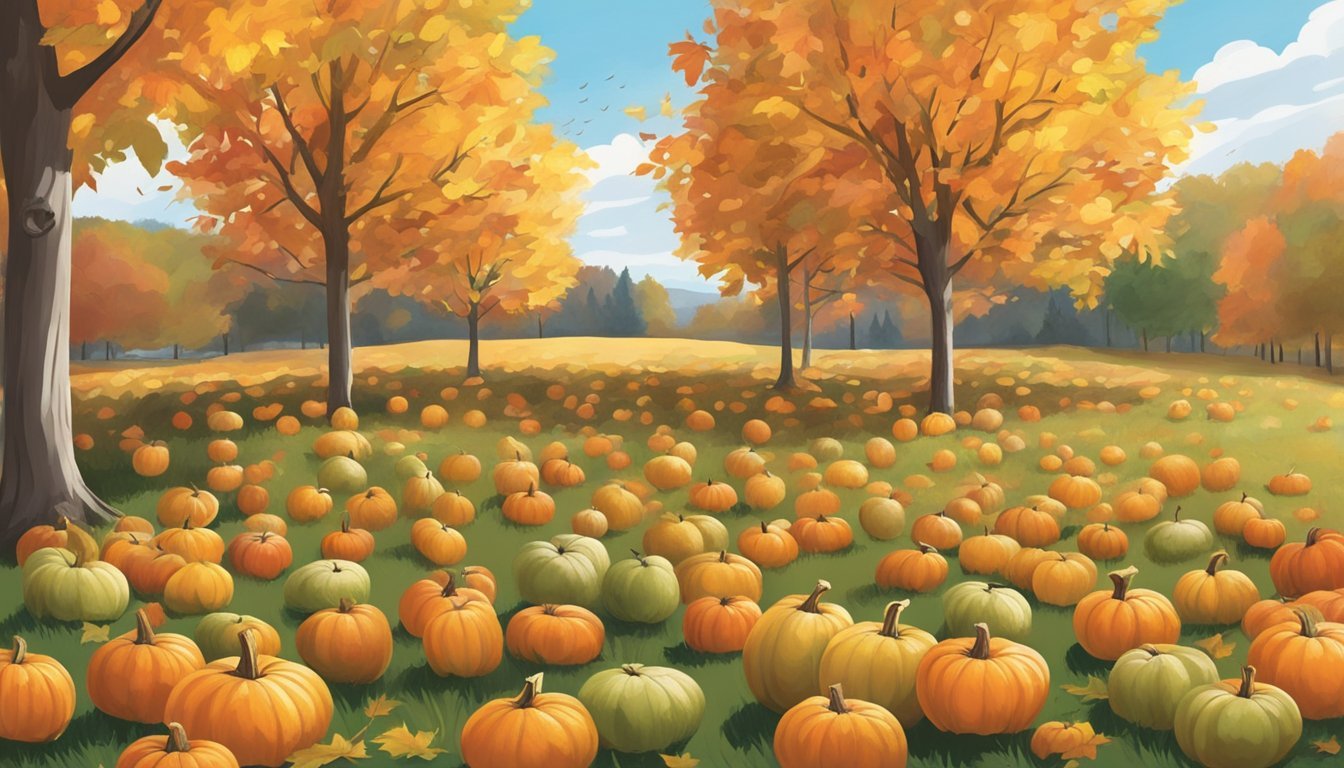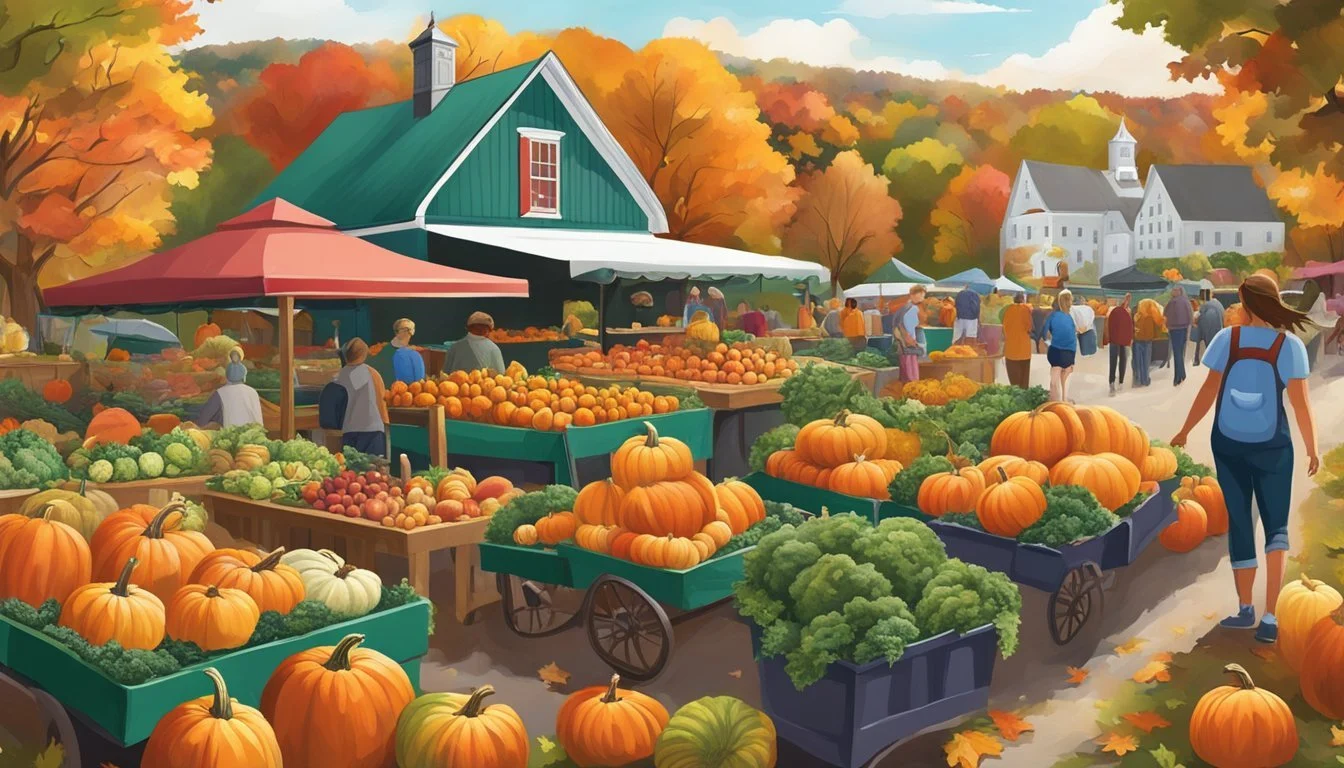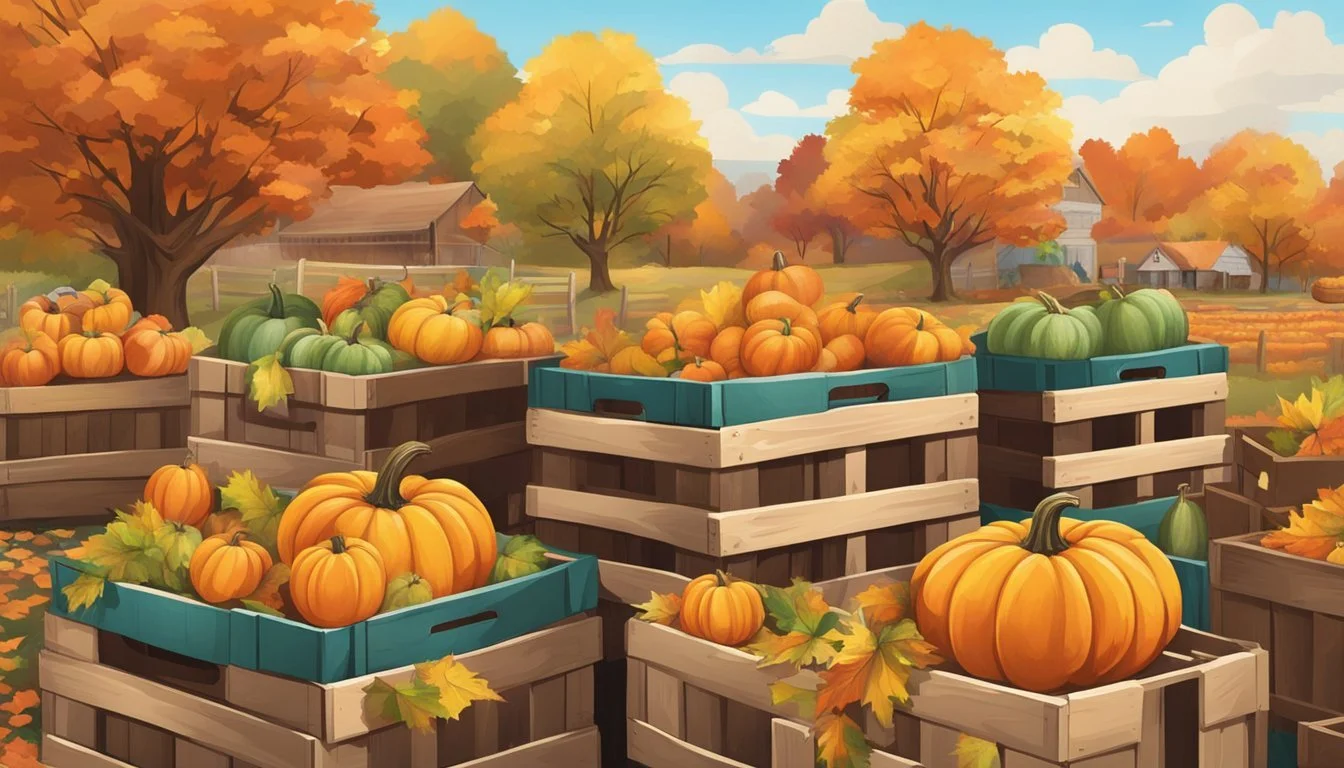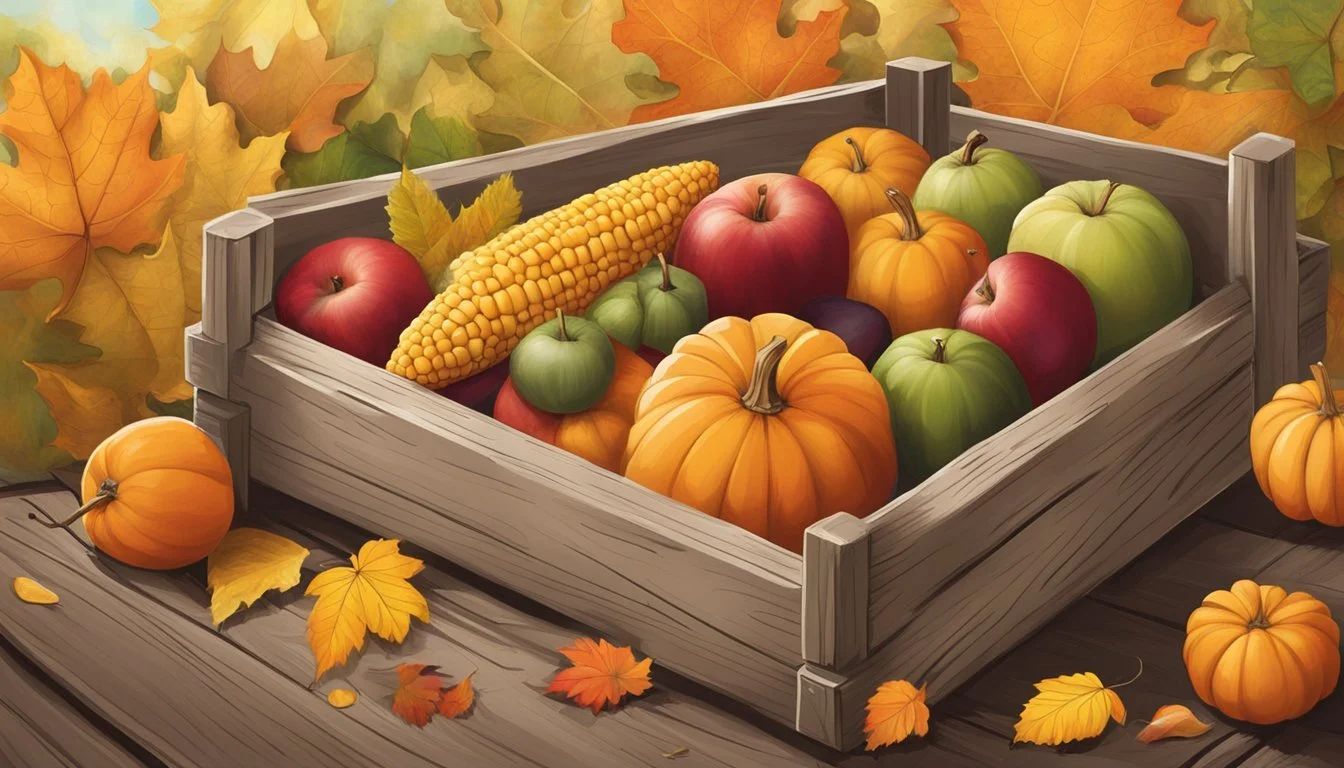Vermont Seasonal Fruit & Vegetables in October
A Guide to Autumn Harvest
This Article is Part of our Vermont Seasonal Fruit & Veg Calendar
October in Vermont brings a rich tapestry of colors, not just on the trees, but also in its harvest. With autumn in full swing, a diverse array of fruits and vegetables reach their peak, offering flavors and nutritional benefits that are best enjoyed in-season. Local produce markets fill with the bounty of the harvest, where Vermonters and visitors alike can experience the state's agricultural offerings at their finest.
Vermont's cool climate shapes a unique growing season, dictating which crops thrive and when. The month of October is particularly known for a variety of root vegetables and hardy greens that withstand the chill in the air. Apples, a hallmark of Vermont's fall, are at the end of their peak season, yet still abundantly available and full of flavor. Additionally, October's cooler temperatures sweeten some varieties of berries, while squash and pumpkins become staples, reflecting the essence of fall both in taste and tradition.
Overview of Vermont's Seasonal Produce
In October, Vermont's fields and orchards are abundant with a variety of produce ripe for harvest. Apples are among the most prominent fruits available, with numerous varieties ready to be picked. Likewise, pumpkins take center stage, becoming a staple for decoration and culinary uses alike.
The state's market stands and farmers markets showcase a range of vegetables as well. Root vegetables such as carrots (how long do carrots last?)and beets (how long do beets last?) retain their high quality during this month. They are joined by other hearty selections like kale, brussels sprouts (how long do brussels sprouts last?), and parsnips, which can withstand the cooler temperatures.
Here's a snapshot of Vermont's typical October offerings:
Fruits:
Apples
Pears
Vegetables:
Beets
Broccoli
Brussels sprouts
Cabbage
Carrots
Cauliflower (how long does cauliflower last?)
Kale
Leeks
Parsnips
Potatoes
Pumpkins
Radishes
Spinach
Turnips
Due to the state’s commitment to supporting local agriculture, there's easy access to these seasonal items. The widespread availability of these foods across the state ensures that residents and visitors alike can enjoy fresh, locally-grown produce.
October's Harvest: Vegetables
In Vermont, the month of October ushers in a bountiful period for vegetables that thrive in the cool fall weather. The state's soil and climate conditions are particularly conducive to the growth of a variety of root vegetables and cruciferous greens.
Root Vegetables:
Beets: These vibrant root vegetables reach peak sweetness and are ready for harvest.
Carrots (how long do carrots last?): They continue to sweeten as the temperatures drop.
Radishes: Known for their peppery flavor, radishes are harvested in October.
Sweet Potatoes: A sweeter and richer alternative to regular potatoes, harvested this month.
Squash and Pumpkins:
Butternut, Acorn, and other winter squashes are at their prime, offering rich and versatile flavors.
Pumpkins become a staple not only as decorations but also as ingredients in hearty, fall recipes.
Cruciferous Vegetables and Greens:
Brussels Sprouts: These become sweeter with a touch of frost and are a common sight.
Cauliflower: Available in white and purple varieties, it's perfect for autumnal dishes.
Kale: This nutrient-dense leafy green is particularly hearty and can withstand cooler temperatures.
Leeks: A milder relative of onions, leeks add subtle depth to soups and stews.
The fall harvest is quintessential for chefs and home cooks alike, who eagerly utilize these ingredients in seasonally inspired dishes. It's the time when farmers' markets and local produce stands proudly showcase the rich and earthy hues of Vermont's October vegetable harvest.
October's Harvest: Fruits
October in Vermont is a picturesque month as leaves turn and harvest season is in full swing. Several fruits come into their prime, offering fresh and flavorful options for consumers. Below is an overview of the key fruits ripe for picking during this time.
Apples: A staple of the Vermont fall harvest, a variety of apples are available. Orchards often offer a range from tart to sweet, including but not limited to McIntosh, Honeycrisp, and Gala.
Pears: While not as abundant as apples, pears such as Bartlett and Bosc reach maturity and can be enjoyed for their soft, buttery flesh.
Cranberries: A quintessential autumn fruit, cranberries are typically ready for harvest in October. They are often found in bogs and are known for their tart flavor and vibrant red hue.
Grapes: Vineyards harvest several grape varieties in early to mid-October before the first frost. They range in flavor from sweet to tart, used in both winemaking and for fresh consumption.
Choosing local produce not only supports Vermont's agricultural economy but also provides the freshest seasonal fruits to consumers. Each of these fruits is part of the state's autumnal bounty and can be found at local markets, farm stands, or pick-your-own farms.
It's important to appreciate the hard work and dedication that goes into cultivating these crops. The fruits listed are subject to natural growing conditions and may vary year to year. For the most accurate information on specific varieties and their availability, it's best to contact local orchards directly.
Fall Flavors and Recipes
October in Vermont bursts with the tastes of fall, and the local produce reflects the rich colors and flavors of the season. Apples, a quintessential autumn fruit, are abundant and perfect for classic recipes. One can make a warm apple crisp with cinnamon, or turn these ripe fruits into a smooth and tangy apple sauce — an ideal complement to roasted pork.
Pumpkins are not far behind in their popularity, as they come to symbolize the heart of fall cooking. Versatile in nature, pumpkins can be transformed into a creamy pumpkin soup or baked into moist pumpkin bread. For those who enjoy salads, adding roasted pumpkin can offer a sweet and earthy flavor to a mixed greens salad.
Table: Seasonal October Produce in Vermont
Fruit Recipe Ideas Apples Pie, Crisp, Sauce, Butter Pumpkins Soup, Pie, Bread, Roasted, Puree Cranberries Sauce, Baked Goods, Relish
Cranberries, another fall staple, offer a tart contrast that can brighten up any dish. They are often made into a cranberry sauce, which is a delightful addition to any Thanksgiving table. Additionally, cranberries can be incorporated into baked goods or tossed into a salad for a pop of color and flavor.
Recipes featuring these ingredients capture the essence of the season and provide comforting, nourishing meals. Vermont's local produce in October inspires many to discover the joys of seasonal cooking and to savor the flavors that autumn so generously provides.
Preparing Your Garden for Winter
As October's crispness foreshadows the coming winter in Vermont, gardeners should focus on safeguarding their plants against the cold. Winter preparation is crucial to protect the hard work invested throughout the year.
First and foremost, one must remove any spent annuals and harvest tender vegetables such as tomatoes, zucchini, and beans to prevent damage from frosts. It is important to clear debris and leftover crops to decrease the likelihood of diseases carrying over into the next planting season.
In perennial gardens, one should consider cutting back dead foliage to promote healthy growth in spring. Mulching is vital; a protective layer can conserve soil moisture, maintain consistent soil temperatures, and protect the root systems of perennials and herbs.
A strategy often overlooked but paramount involves soil care. Integrating compost into garden beds enhances nutrient content and improves the soil structure for the subsequent growing season. Despite the cold, winter temperatures can be beneficial, as the freezing of soil helps in eradicating pests and diseases naturally.
In October, planting cover crops such as rye or clover can provide numerous benefits. They prevent soil erosion, suppress weeds, and improve soil quality for next year's plants.
Finalizing preparations, gardeners should also consider garden infrastructure. Repairing or installing fences, trellises, and plant supports during this time will lead to fewer chores in the busy spring months.
By following these steps, Vermont gardeners can rest assured their gardens will emerge from winter's grasp ready for a successful new year.
The Importance of Eating Seasonally
Eating seasonally involves selecting fruits and vegetables that are naturally at their peak during certain times of the year. In Vermont, October's harvest offers a bounty of produce that is not only fresher but also packed with health benefits.
Health Benefits: Seasonal produce is harvested at the right time, meaning it has had enough time to grow and develop all its nutrients and flavors. This often results in higher levels of antioxidants and phytochemicals, compounds that are vital for maintaining health and preventing diseases.
Local Economy: By choosing local, seasonal items, consumers support the regional farmers and the economy. This investment helps to sustain the agricultural community and preserve the local farming industry.
Sustainability: Seasonal eating supports a more sustainable food system. It entails lower transportation distances for produce, which in turn reduces carbon emissions, packaging waste, and the overall environmental footprint.
Environmental Impact:
Less water and land use
Reduced pollution and soil degradation
Incorporating seasonal fruits and vegetables into meals is an excellent way to diversify one's diet. This variety ensures a wider intake of essential nutrients and supports overall well-being. As the climate cools in October in places like Vermont, the selection of available produce changes, offering a unique opportunity to adapt and enjoy the seasonal flavors that nature provides.
Storing and Preserving October Produce
In Vermont, October brings a harvest rich in root vegetables, squashes, and apples. Proper storage and preservation techniques ensure these autumnal delights maintain quality and flavor through the colder months.
Root Vegetables like beets, carrots, and potatoes favor cool, dark environments. They should be stored in a root cellar or a cool basement, ideally at temperatures ranging between 32°F to 40°F with moderate humidity. Remove any excess soil, but do not wash them before storage to prevent spoilage.
Squash, including pumpkins, acorn, and butternut squash (how long does butternut squash last?), require a slightly warmer storage climate, about 50°F to 60°F with lower humidity. Once cured for 10-14 days in a warm, well-ventilated area, they can be stored in single layers to avoid pressure spots and ensure air circulation.
For Apples, refrigeration is key. They can be kept in a crisper drawer separate from other produce to prevent ethylene gas from accelerating ripening in vegetables. Apples stored around 32°F can last for several months.
Preservation methods provide further longevity:
Freezing: Blanch root vegetables before freezing to preserve texture and flavor. Squash can be cooked and puréed or cut into pieces before freezing.
Canning: Apples can be made into sauces or jams. Squash and certain root vegetables can also be canned, provided they are processed correctly to maintain safety.
Here is a quick reference table for common October produce in Vermont:
Produce Storage Method Shelf Life Root Vegetables Cool, dark, humid Several months Squash Warm, dry, airy 2-3 months Apples Refrigeration Up to several months
Each method preserves the bounties of October, allowing them to be savored well into the winter season.
Vermont's Seasonal Produce Calendar
October in Vermont is a celebration of fall's bounty, marking a transition from the lush growth of summer to the heartier, cold-weather produce. Farmers and gardeners gather their harvests before the first frost sets in, offering an array of vibrant and nutritious produce.
During this autumnal month, Vermont's farms deliver:
Vegetables Fruits Beets Apples Broccoli Pears Brussel Sprouts Cabbage Carrots Cauliflower Kale Leeks Lettuce Onions Parsnips Potatoes Pumpkins Radishes Spinach Squash Turnips Winter Squash
In October, they enjoy the late yields of vegetables like carrots and potatoes, which are staples for comforting, seasonal dishes. The celebrated pumpkin and various types of winter squash also take the spotlight, perfect for both savory and sweet culinary creations. Apples and pears remain the highlight in the fruit section, with their crisp and sweet flavors enriching the palates of locals and visitors alike.
Moreover, root vegetables like beets, parsnips, and turnips are widely available and offer robust flavors and the versatility to be stored for use throughout the winter months.
Availability varies by specific weather patterns and farm practices. To ensure the freshest produce, one should check with local farmers' markets and farm stands, as they regularly update their current offerings based on the latest harvest.







